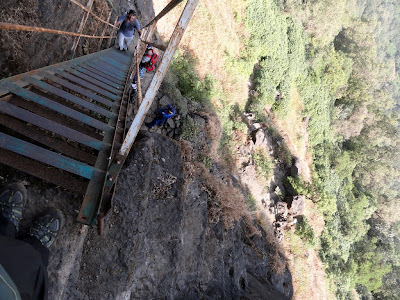On one particular Thursday I got to know that a local trekking group is about to go on a Kalsubai (highest peak in Maharashtra) and Ratangad (One of Shivaji's favourite forts) double trek. They were to leave on the very next day i.e. Friday. The usual thrill to plan and make it happen in such a short time was enthralling. Friday afternoon I booked my berth on that evenings bus along with the fellow trekkers! Fortunately, it was a small group of 10 people. Less noise and more maturity! ;)
Pune - Shendi - Baari - Kalsubai
We started on Friday night at around 11:30 PM. The plan was to reach Baari village, the base of Kalsubai and the starting point of one of the best known routes, in about 5-6 hours and rest wherever we could before starting the trek. What with nobody knowing the exact route and the over-confidant driver enacting as if he is driving a sports car, and the curvy mountain roads, we landed in another village called Shendi. Shendi is slightly towards south of Baari (about 10-15 km). At roughly 5:00/5:30 AM, we just parked the bus in what looked like the village square and slept in the bus. An hour or so later, we woke up, had tea breakfast and after finding about the exact route to Baari, moved on.
Before reaching Baari/Bari, there is a board near Pendshet that announces the easiest route to Kalsubai (This was nowhere mentioned on any blogs so we were sceptical). The local villagers from Baari later told us that this was just a political ploy by the administrators or the villagers from Pendshet. So, if you do go, avoid that route.
After reaching Baari we got set and began the trek. Kalsubai, even though the highest peak in Maharashtra, is not the highest climb. The route continuously ascends but is not difficult.
 |
| Trek begins towards the Kalsubai peak hidden behind a cloud. |
Some of us thought that we should reach the top after we climb the ladders, but that was just 50% of the route. More walking!
 |
| Beyond ladders. Kalsubai is the second peak from the left. |
 |
| Range around Kalsubai |
 |
| Route from Bari/Baari to Kalsubai peak |
From Baari, our bus took us back to Shendi, and then via Bhandardara dam, we reached that quaint little village called Ratanwadi. Ratanwadi is know for Amruteshwar Mandir. I was really impressed by the clean village.
 |
| Amruteshwar Mandir, Ratanwadi |
Early morning on the second day, we started moving towards Ratangad. It is a scenic route that takes you along a brook, forests and then another set of ladders.
This definitely is one of the beautiful trekking routes I've come across so far. It's pleasing to the eye, shades you from the sun, and broadcasts the lovely sounds of birds.
On reaching the ladders, you'll see that there are stone cut steps as well besides the ladders.
 |
| Ladder on the left, steps on the right. |
After spending some time and gulping some food, we started back. Completing our double trek.
 |
| Ratangad route via Ratanwadi |



